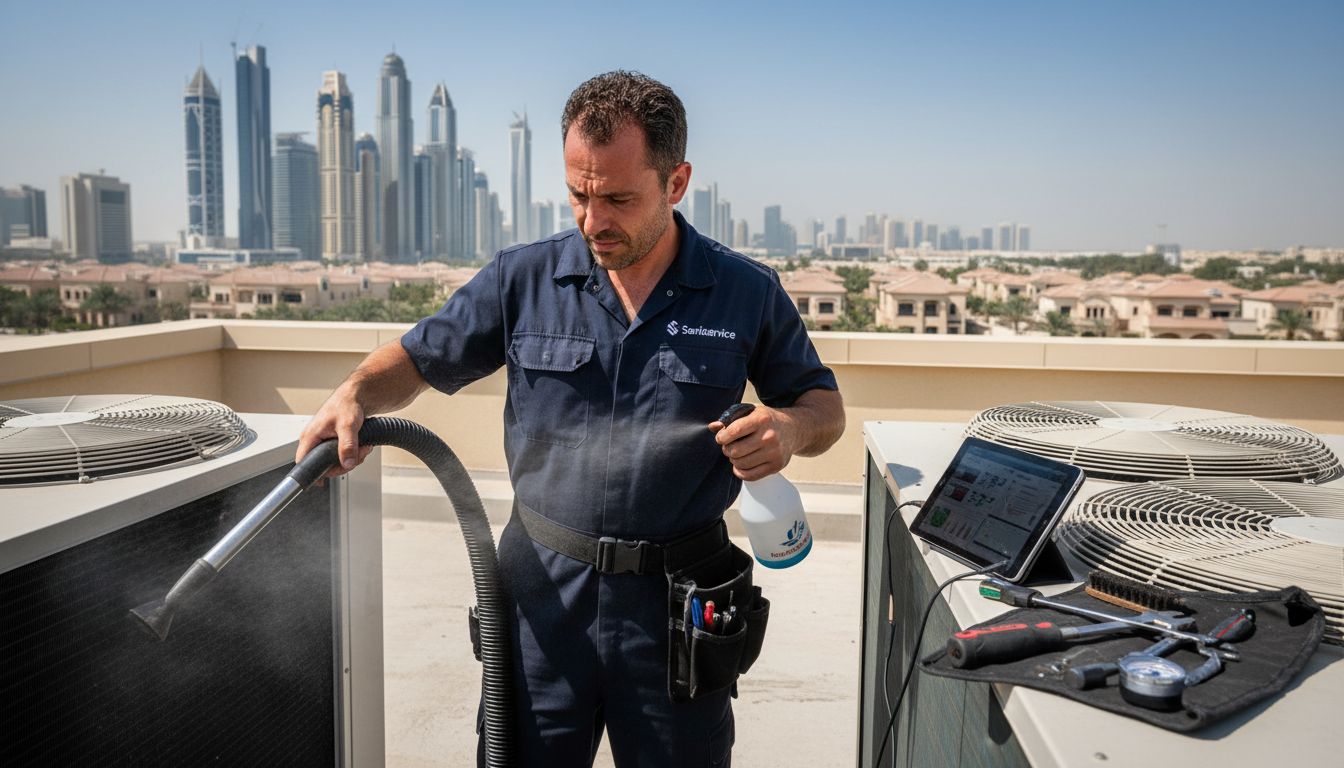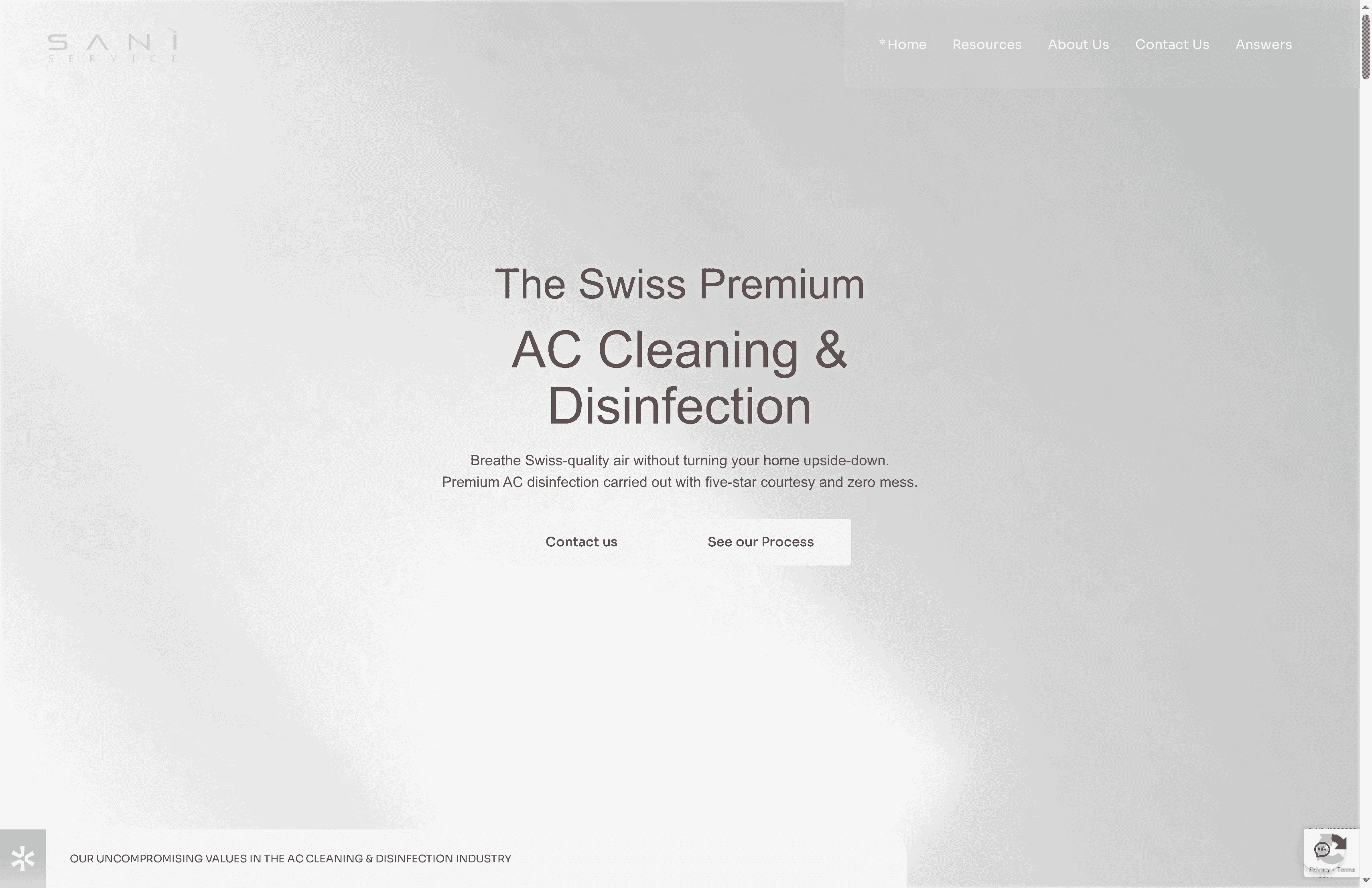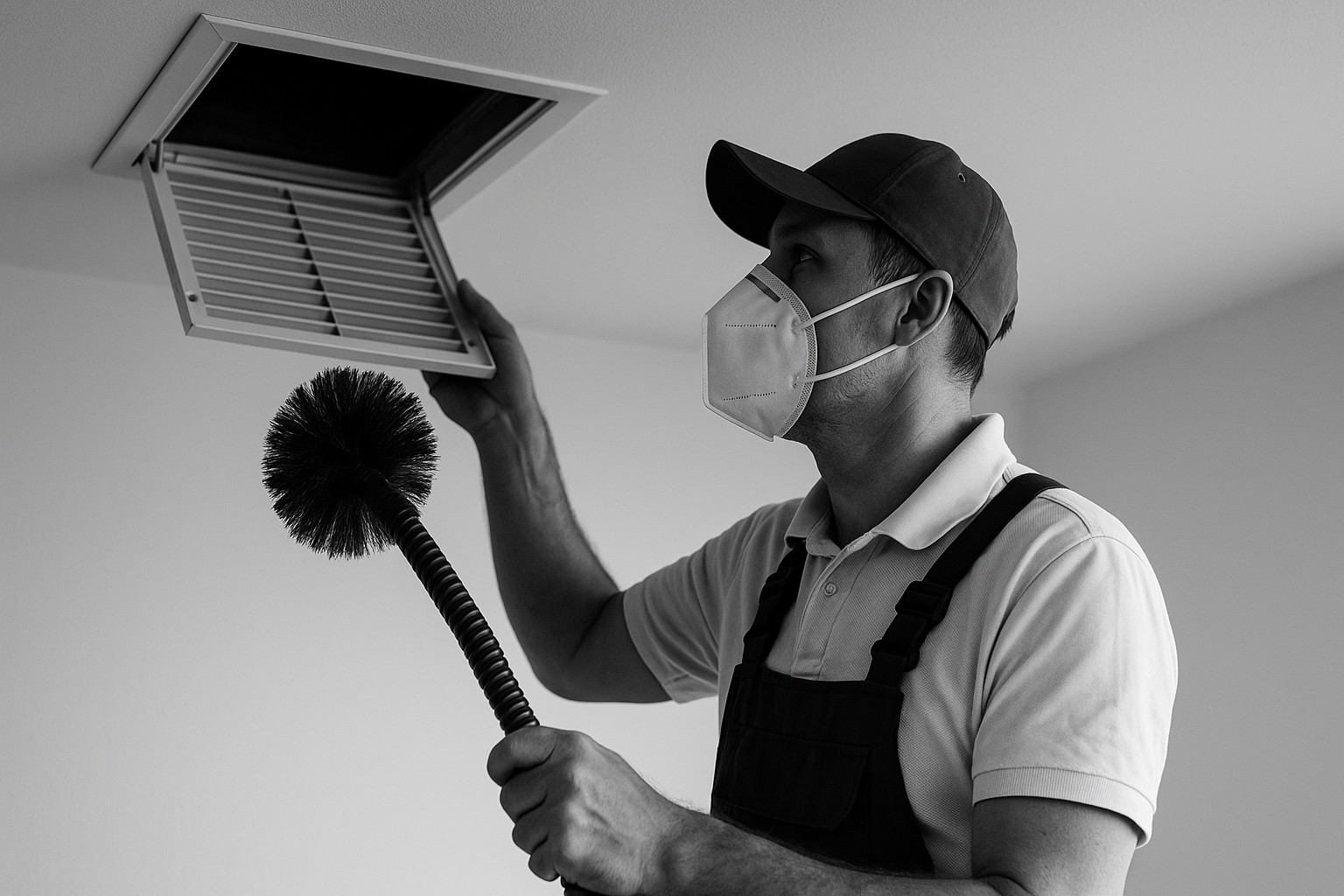
HVAC Cleaning vs Maintenance: Complete Guide
Most american homeowners are surprised to learn that neglecting proper HVAC cleaning or skipping routine maintenance can reduce system efficiency by as much as 40 percent. In a climate like Dubai, where extreme heat puts extra pressure on every building’s air conditioning, understanding this difference becomes crucial. Whether you manage a villa or a commercial property, recognizing what sets cleaning apart from maintenance helps protect your investment, reduce costs, and keep your indoor air healthier all year long.
Table of Contents
Contents
- 1 Table of Contents
- 2 Key Takeaways
- 3 HVAC Cleaning vs Maintenance Explained
- 4 Key Components Involved in Each Process
- 5 How HVAC Cleaning and Maintenance Work
- 6 Benefits and Expected Outcomes of Each
- 7 Risks, Costs, and Common Mistakes to Avoid
- 8 Ensure Peak HVAC Performance with Expert Cleaning and Maintenance
- 9 Frequently Asked Questions
- 10 Recommended
- HVAC Cleaning vs Maintenance Explained
- Key Components Involved in Each Process
- How HVAC Cleaning and Maintenance Work
- Benefits and Expected Outcomes of Each
- Risks, Costs, and Common Mistakes to Avoid
Key Takeaways
| Point | Details |
|---|---|
| Difference Between Cleaning and Maintenance | HVAC cleaning focuses on removing biological contaminants, while maintenance ensures mechanical reliability and performance. |
| Recommended Frequency | HVAC cleaning should be performed 1-2 times a year, whereas maintenance should happen quarterly or semi-annually. |
| Benefits of Regular Services | Regular HVAC cleaning and maintenance can enhance indoor air quality, extend equipment lifespan, and reduce energy consumption. |
| Risks of Neglect | Failure to properly maintain HVAC systems can lead to increased costs, reduced efficiency, and potential health risks due to contamination. |
HVAC Cleaning vs Maintenance Explained
Understanding the critical differences between HVAC cleaning and maintenance is essential for property owners in Dubai seeking optimal indoor air quality and system performance. According to research from ATI Restoration, these two processes serve distinct yet complementary functions in preserving your air conditioning system’s health and efficiency.
HVAC cleaning specifically targets the removal of contaminants such as dust, mold, bacteria, and allergen buildup within your system’s components. This process involves comprehensive decontamination of air ducts, coils, drainage trays, and blower units to prevent potential health risks and maintain optimal indoor air quality. HVAC Cleaning Explained: Science, Methods, and Impact provides deeper insights into the scientific approach behind thorough air system sanitization.
On the other hand, maintenance focuses on the mechanical and operational aspects of your HVAC system. This includes regular professional inspections, lubricating moving parts, checking electrical connections, testing system performance, and making necessary adjustments to ensure long-term functionality. Maintenance helps prevent unexpected breakdowns, improves energy efficiency, and extends the overall lifespan of your air conditioning equipment.
Key differences between cleaning and maintenance include:
- Cleaning: Removes biological contaminants and improves air quality
- Maintenance: Ensures mechanical reliability and system performance
- Cleaning Frequency: Recommended 1-2 times annually
- Maintenance Frequency: Quarterly or semi-annual professional inspections
For Dubai residents managing luxury villas or commercial spaces, integrating both cleaning and maintenance strategies is crucial. AC Cleaning vs Maintenance: Complete Guide for Dubai offers comprehensive recommendations tailored to the unique environmental conditions of the United Arab Emirates.
Key Components Involved in Each Process
In the realm of HVAC systems, understanding the specific components involved in cleaning and maintenance is crucial for property owners in Dubai. According to Strada Services, the complexity of air conditioning systems requires targeted approaches to ensure optimal performance and longevity.
HVAC Cleaning Components focus primarily on biological and particulate contamination removal. This includes comprehensive sanitization of critical system elements such as:
- Air ducts and ventilation pathways
- Evaporator and condenser coils
- Drainage trays and condensate lines
- Blower units and fan assemblies
- Air intake and return grilles
Maintenance Components, by contrast, emphasize mechanical and electrical system integrity. Ciele Weigle highlights that maintenance involves inspecting and servicing:
- Electrical connections and control systems
- Refrigerant levels and pressures
- Mechanical moving parts
- Motor and compressor performance
- Lubrication of mechanical components
- Air filter replacement
In the unique climate of Dubai, where extreme temperatures and high humidity create challenging environmental conditions, both cleaning and maintenance processes are critical. SaniAC by Saniservice recommends a holistic approach that integrates thorough cleaning with systematic maintenance to protect your HVAC investment and ensure optimal indoor air quality.
Professional technicians trained in indoor air science understand that each component plays a vital role in system performance. By addressing both biological contaminants and mechanical systems, property owners can significantly extend equipment lifespan, reduce energy consumption, and maintain a healthier indoor environment.
How HVAC Cleaning and Maintenance Work
Understanding the intricate processes behind HVAC cleaning and maintenance is essential for property owners in Dubai seeking optimal system performance. Oxygenland highlights that these processes are far more complex than simple routine checkups, involving systematic approaches to ensure comprehensive system health.
HVAC Cleaning Process:
- Initial system inspection and assessment
- Complete system shutdown and isolation
- Detailed disassembly of system components
- Specialized cleaning of individual parts:
- Comprehensive removal of dust and biological contaminants
- Sanitization of air ducts and ventilation pathways
- Thorough decontamination of coils and drainage systems
- High-precision sanitization using hospital-grade, chemical-free biosanitizers
- Reassembly and performance testing
HVAC Maintenance Process:
- Comprehensive system diagnostics
- Mechanical component evaluation:
- Checking electrical connections
- Assessing refrigerant levels
- Lubricating moving parts
- Inspecting motor and compressor functionality
- Performance optimization procedures
- Predictive analysis to prevent potential system failures
- Detailed documentation and recommendations
For Dubai residents managing luxury properties, understanding these nuanced processes is critical. 7 Essential Steps for an Effective HVAC Maintenance Checklist provides additional insights into maintaining your HVAC system’s peak performance in the challenging UAE climate. Professional technicians from SaniAC by Saniservice employ scientific precision to ensure your indoor environment remains healthy, efficient, and comfortable.
Benefits and Expected Outcomes of Each
HVAC cleaning and maintenance are not just routine procedures but strategic investments in your property’s comfort and efficiency. Project HVAC reveals that these processes deliver substantial benefits beyond simple system upkeep, particularly in challenging climates like Dubai.
Benefits of HVAC Cleaning:
- Eliminates harmful biological contaminants
- Improves indoor air quality significantly
- Reduces potential respiratory health risks
- Prevents microbial growth in system components
- Enhances overall system airflow efficiency
- Minimizes unpleasant odors in living spaces
Benefits of HVAC Maintenance:
- Extends equipment operational lifespan
- Reduces unexpected breakdown risks
- Optimizes energy consumption
- Prevents costly emergency repairs
- Maintains consistent system performance
- Ensures warranty compliance
According to Neal’s Heating and Air, preventive maintenance can potentially reduce energy bills by up to 15% and decrease the likelihood of major system failures by 40%. For Dubai’s luxury property owners, these benefits translate directly into enhanced property value and resident comfort.
SaniAC by Saniservice recommends a holistic approach that integrates both cleaning and maintenance, ensuring your HVAC system operates at peak efficiency while maintaining the highest standards of indoor air quality. By investing in these scientific, precise services, property owners can protect their equipment, reduce long-term costs, and create healthier indoor environments.
Risks, Costs, and Common Mistakes to Avoid
Navigating the complex world of HVAC maintenance requires a strategic approach to minimize potential risks and unexpected expenses. Universal Duct Cleaning warns that seemingly minor oversights can lead to significant system complications, especially in Dubai’s challenging environmental conditions.
Common HVAC Cleaning Mistakes:
- Attempting DIY cleaning without proper equipment
- Incomplete or superficial component sanitization
- Neglecting comprehensive airflow testing
- Using inappropriate cleaning chemicals
- Failing to address underlying moisture issues
- Ignoring specific manufacturer guidelines
Potential Risks and Cost Implications:
- Reduced system efficiency by 20-40%
- Increased energy consumption
- Premature equipment failure
- Voided manufacturer warranties
- Potential health risks from microbial contamination
- Substantial unexpected repair expenses
Horizon Air Solutions indicates that neglecting regular maintenance can escalate repair costs by up to 75%, transforming a routine service into a major financial burden. For Dubai’s luxury property owners, these risks are particularly significant given the region’s extreme temperatures and high humidity levels.
SaniAC by Saniservice recommends a proactive, scientifically validated approach to HVAC care. By investing in professional cleaning and maintenance services, property owners can mitigate risks, control long-term costs, and ensure optimal system performance in the most demanding environmental conditions.
Ensure Peak HVAC Performance with Expert Cleaning and Maintenance
The comprehensive guide you just explored highlights the critical need to balance HVAC cleaning and maintenance for healthier indoor air and optimal system efficiency. Ignoring either can lead to costly repairs, poor air quality, and reduced comfort—challenges that Dubai property owners cannot afford in the harsh climate. If you want precise, science-based solutions that address biological contaminants and mechanical integrity simultaneously, partnering with experts is essential.
Discover how Saniservice leverages Swiss-quality service and cutting-edge microbiology to meticulously clean and maintain every AC component. Our NADCA-certified technicians use hospital-grade, chemical-free biosanitisers combined with rigorous mechanical inspections to extend your system’s life while ensuring safer, cleaner air. Learn from real-life successes in our Case Studies – Saniservice AC Cleaning and explore detailed service offerings at AC Cleaning & Maintenance – Saniservice AC Cleaning.
Take control of your indoor environment today. Experience measurable improvements in air quality, energy efficiency, and system reliability by scheduling your professional HVAC cleaning and maintenance with Saniservice. Visit our site now at https://saniacservice.com to secure your healthier, more comfortable home or workspace.
Frequently Asked Questions
What is the difference between HVAC cleaning and maintenance?
HVAC cleaning focuses on removing biological contaminants and improving indoor air quality, while HVAC maintenance ensures mechanical reliability and optimal system performance.
How often should I schedule HVAC cleaning and maintenance?
It is recommended to have HVAC cleaning done 1-2 times annually and maintenance inspections performed quarterly or semi-annually to ensure optimal performance.
What are the key components involved in HVAC cleaning?
Key components of HVAC cleaning include air ducts, evaporator and condenser coils, drainage trays, blower units, and air intake and return grilles, all of which require thorough sanitization.
What are the benefits of regular HVAC maintenance?
Regular HVAC maintenance extends equipment lifespan, optimizes energy consumption, reduces unexpected breakdowns, and ensures consistent performance while also maintaining warranty compliance.
Recommended
- Best Air Duct Cleaning Companies Near Me – Expert Comparison 2025 – Saniservice AC Cleaning
- AC duct cleaning providers offering service bundles with HVAC maintenance – Saniservice AC Cleaning
- HVAC Cleaning Process 2025: Step-By-Step Guide for Healthier Air – Saniservice AC Cleaning
- HVAC Cleaning Explained: Science, Methods, and Impact – Saniservice AC Cleaning








Leave a Reply